Cooking was just the medium to discover our cultures
together!
It was great having Vandana come over to my apartment to
prepare a South Indian meal together! Our rendezvous over
the cooking activity was less about cooking and more about
knowing each other.
For me as an Indian, it was getting to know my counterpart
born and brought up in the US but raised with Indian values.
While cooking the hot, delicious sambar or while making the
soft, fluffy dosas or steaming the rice I realised the
similarities in our growing up and discovered how an Indian
born in the US views India.
Although not an expert, Vandana knew many of the recipes of
Indian dishes from her mother. Her neatly chopped tomatoes
and onions helped make the sambar tastier. The ready to cook
ingredients available ubiquitously across Indian stores in
the US made our job easy.
The day I am discovery America every day of my first visit
to the US, I look forward to Vandana making her first visit
to India as an adult and have the joy of discovering her
roots .. I hope our interaction together through such
activities increases her curiosity about India.
-Kiran
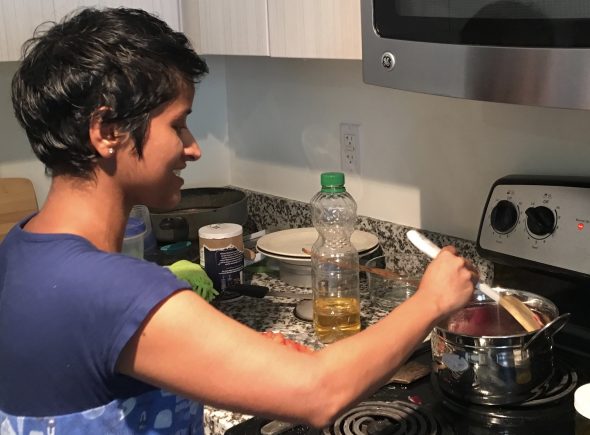
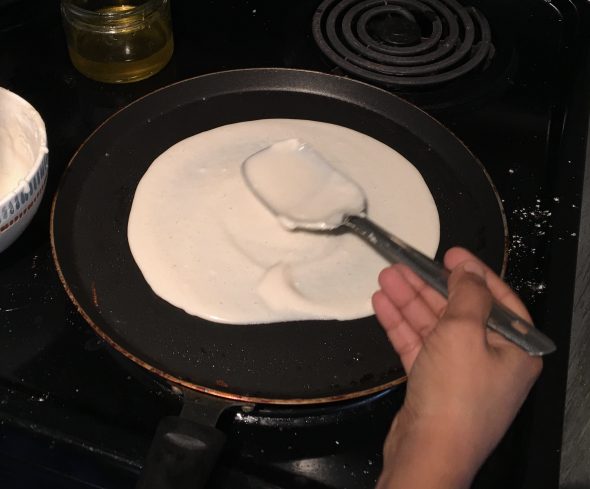
One culture, two perspectives
When Kiran and I were first assigned to be each
other’s blogging buddy and to complete this
assignment, someone jokingly remarked that it was sort of
like cheating, giving that we’re both of Indian
origin — wouldn’t that fact maybe diminish our
opportunity to learn about a culture different from our
own? However, while I understand this thought process, I
wasn’t personally worried about losing anything by
being paired with another Indian person. While Kiran and I
do share an ethnicity, our life experiences are
vastly different, creating the unique situation in which
we share a level of common cultural understanding in spite
of having lived much of our lives in different countries
from one another.
Although I was born in Chennai, Tamil Nadu, India, my
family moved to the United States when I was 4 months old.
Furthermore, the town I lived in for 18 years —
Carson City, Nevada — is somewhat small and tucked
away, a far cry from the streets of Mumbai, where Kiran is
from. Nevertheless, our shared ethnicity serves as a sort
of tether between us and to our country of origin. I was
excited to make a meal with Kiran and learn more about the
common ground between us, as well as our various
differences.

Kiran’s hometown of Mumbai. Image credit:
Maharashtra Times.

The view in front of my family’s house in Carson
City, Nevada. Photo credit: my dad
As Kiran said, our exercise was less about cooking and more
about getting to know each other. After all, in spite of
being raised in the US, my mom made sure to make us Indian
food nearly every day; I’m no stranger to the flavors
of our homeland or how they’re combined and prepared.
The meal we chose to make was quite simple. Kiran had
prepared some of the ingredients, such as the dosa batter,
in advance, and we used a ready-to-cook sambar mix for our
sambar, making the cooking process pretty easy. All we had
to do was chop the tomatoes and onions, put some rice in the
rice cooker, and fry up the dosas. While we cooked, we
talked a bit about our lives and bonded over our shared
connection to Indian food and culture.

Freshly prepared dosa
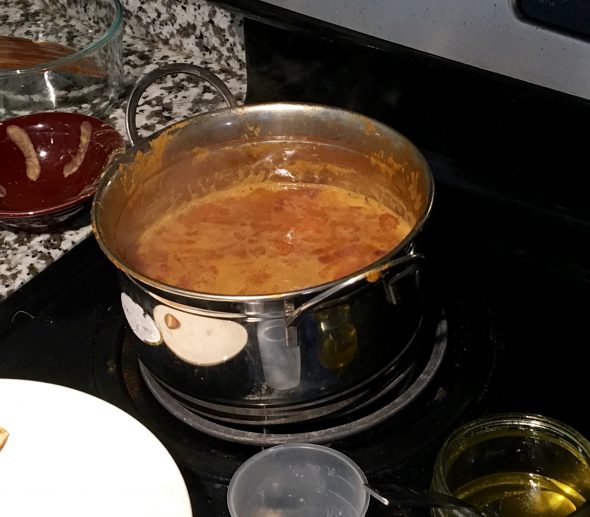
Hot sambar

A dosa being prepared

Sambar being prepared
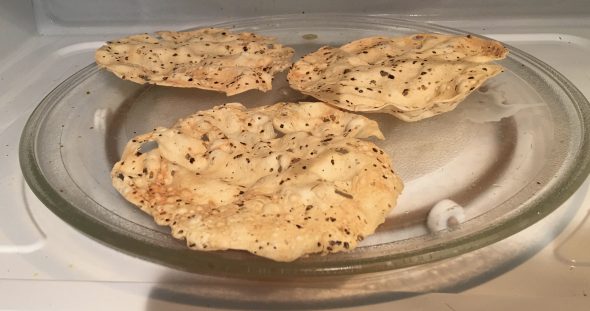
Papadums being warmed up
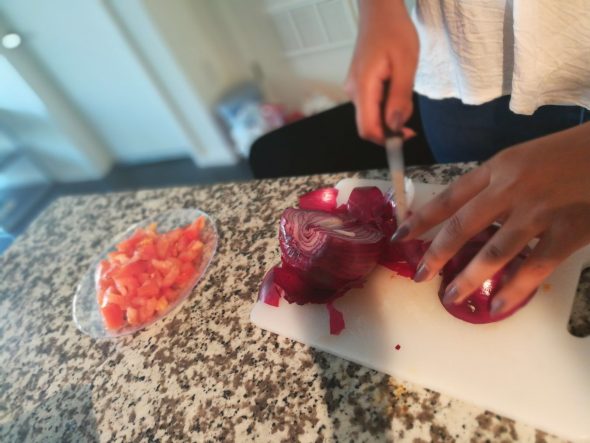
Chopping onions and tomatoes.
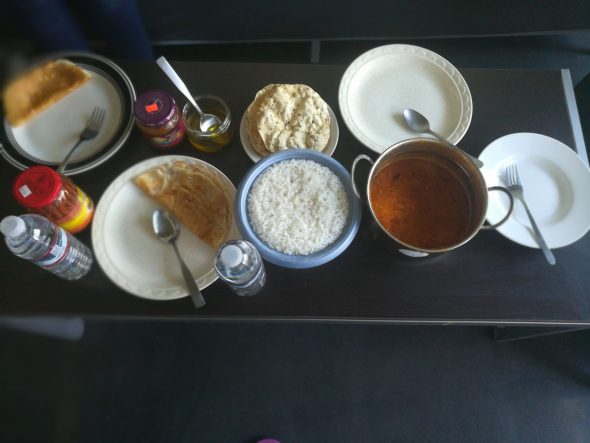
The full spread of food!
When the food was done, Kiran invited Kazi and Szabolcs to
eat with us. I enjoyed talking to all three of them over the
fresh food we had just made, and it reminded me of how
easily food brings people together. It’s one of the
reasons I love to cook and bake food in my own apartment as
well! I was also reminded of how much hospitality and
friendship is valued in our culture. My parents, who grew up
in India and lived there until their early thirties, always
raised me to believe that, when you make something, you try
and share it with others if you can, inviting them to share
in the experience with you. The fact that we actually did so
really rounded out the experience for me — although
all four of us were from different backgrounds and places,
we could sit down and have a nice conversation over a good
meal.
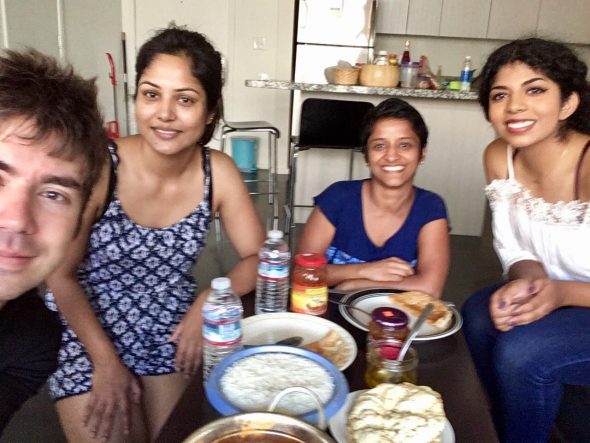
While we ate, Kiran and I talked about my experiences with
Indian culture as an Indian person who grew up largely
outside of the country. Aside from a brief trip back to
India when I was nine years old, I haven’t really
visited India at all, and I certainly haven’t been
there as an adult yet. My family — made up of my two
older brothers, who are studying medicine, and my parents
— wants to go back sometime, but between all of our
busy schedules and our various priorities, it’s
increasingly difficult for us to really get the ball rolling
and make a plan to do so. However, Kiran told me that I
should visit her in Mumbai sometime on my own so that I can
experience the culture independently and on my own schedule.
I completely agree, and I hope that in the future, I can
visit Kiran in Mumbai and reconnect with her there! This
experience definitely sparked my curiosity in delving deeper
into Indian culture independent of my limited experiences
with it, and I’m glad I had the opportunity to connect
with Kiran over the subject and over some good food. I hope
our future blogging assignments add to this experience, and
I’m looking forward to them!
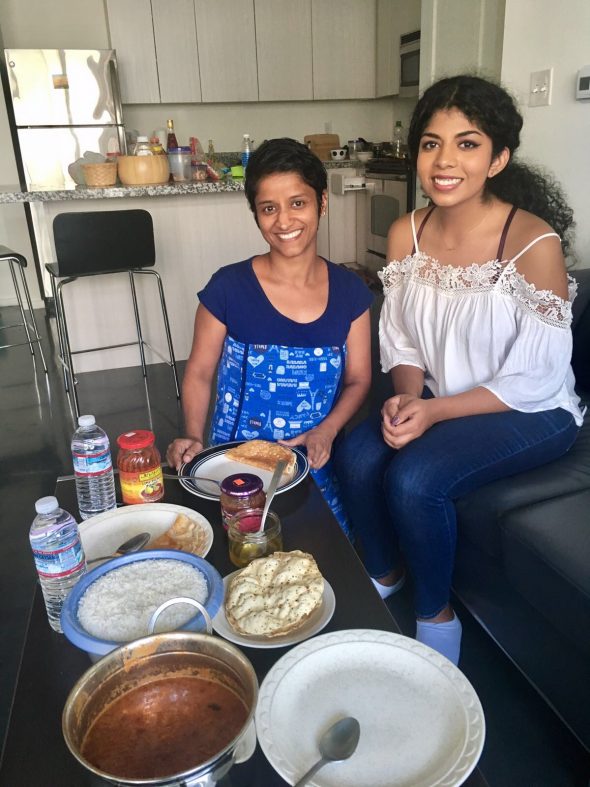
-Vandana


Vandana and Kiran, it was so great to see how you both connected over the similarities in your background, and just how different you are as well. Without having the ready-made dosa batter, how long would it usually take to prepare them from beginning to end?
Thank you! To answer this question, I turned to my mom. Kiran may have a different answer based on how she prepares it, but according to my mom, “you need to soak the lentils overnight or for 7-8 hours, grind it, then leave it out for another 8-12 hours to ferment. Without fermentation, it will not turn out properly. In colder climates, it’s very difficult for fermentation to occur, so I leave it in the oven overnight with the light on for warmth. Then, you can use it directly.” Making the dosas from the batter only takes a few minutes, but the batter itself requires quite a bit of preparation and patience.